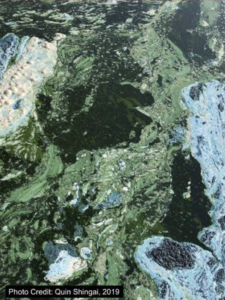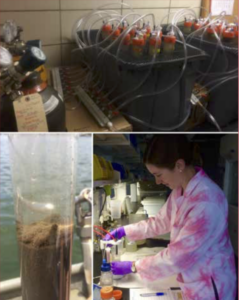Getting into Soil and Water 2020
Nutrient pollution in surface waters – or eutrophication – is a grave social and economic concern for communities across Iowa. Over 90 percent of Iowa lakes and reservoirs are characterized as eutrophic due to very high nutrient levels (IDNR, AQuIA Database, Carlson, 1977). This means that our lakes are vulnerable to algal blooms during the summer months (Figure 1). Algal blooms are one of the most visible and dangerous symptoms of eutrophication as these blooms are linked to concerns such as fish kills and the release of toxins (Smith, 2009).
During the summer of 2018, researchers with the Ambient Lake Monitoring Program found the toxin microcystin in 72 percent of their 128 study lakes across Iowa (IDNR, AQuIA Database). Microcystin is a liver toxin that may be produced during algal blooms by some types of cyanobacteria, commonly called blue-green algae. Exposure to this toxin can cause skin irritation, gastrointestinal distress, and liver damage (Carmichael, 2001). Toxic algal blooms are an obvious public health concern, and they jeopardize the recreational economies of Iowa’s water bodies – an industry valued at around $1 billion statewide, annually (Jeon et al., 2016). As such, there is a pressing need to manage algal blooms in order to protect public health and recreational economies across our state.

Managing Inputs
Preventing algal blooms requires that we reduce nutrient inputs to Iowa surface waters. For lakes and reservoirs, it is especially important to manage phosphorus inputs. Phosphorus is an essential nutrient for all organisms. However, high phosphorus levels in lakes can be “too much of a good thing,” and fuel algal blooms dominated by cyanobacteria (Schindler et al., 2016). Lake phosphorus management typically focuses on reducing watershed phosphorus losses with practices such as cover crops and buffer strips. These efforts are critical for eutrophication management; however, it is also important to consider how phosphorus can be recycled within water bodies. Specifically, phosphorus stored in the sediments at the bottom of a lake can be released into the overlying water if the sediments are disturbed or if chemical conditions change (Søndergaard et al. 2003). This process is referred to as internal phosphorus loading and can maintain high, in-lake phosphorus concentrations even if watershed nutrient inputs are reduced, perpetuating poor water quality (Jeppesen et al., 2005).
Unfortunately, the mechanisms that control internal phosphorus loading are poorly described for the shallow lakes and reservoirs that we have in Iowa. This knowledge gap makes the management of internal phosphorus inputs extremely difficult. How can you prevent something if you don’t know when, where, or why it’s happening? The goal of my graduate research with the Wilkinson Limnology Lab at Iowa State University is to start answering the “when, where, and why” of internal phosphorus loading in shallow lakes. With funding support from the Iowa Water Center, we constructed a sediment core incubation system to measure internal phosphorus loads in Iowa lakes and test the underlying mechanisms (Figure 2). Over the course of last summer, our research team visited several study lakes in western Iowa and collected cores of lakebed sediments and the overlying water. We took these cores back to the laboratory and incubated them under different conditions that lakebed sediments might experience naturally, such as low versus high oxygen levels. Every day the cores were incubated, we collected samples of the overlying water and tested the phosphorus concentration. This measurement allowed us to determine if the sediments were releasing phosphorus over time and if so, how much.

Investigating Mechanisms
Preliminary results from the past summer indicate moderate to high internal phosphorus loading rates in our study lakes. The influence of oxygen levels on sediment phosphorus release varied across different study lakes and between shallow versus deep sites within each lake. Next year, we will continue to investigate the chemical mechanisms responsible for the observed patterns. Testing the mechanisms that control sediment phosphorus release can inform targeted management approaches to reduce internal loading. It is important to note that efforts to reduce internal phosphorus loading will only be effective if watershed inputs are also controlled. Addressing eutrophication in Iowa water bodies requires bold management of both external and internal phosphorus loading.
Ellen Albright
Graduate Research Assistant Department of Ecology, Evolution and Organismal Biology at Iowa State University
References:
Carlson, R.E. 1977. A trophic state index for lakes. Limnology and Oceanography, 22(2): 361-369.
Carmichael, W.W. 2001. Health effects of toxin-producing cyanobacteria: “The CyanoHABs”. Human Ecological Risk Assessment, 7(5): 1393-1407.
Iowa Department of Natural Resources (IDNR). 2018. Water Quality Monitoring and Assessment Section. AQuIA [database]. Retrieved from https://programs. iowadnr.gov/aquia/.
Jeon, H., Ji, Y., and Kling, C.L. 2016. A report to the Iowa Department of Natural Resources: The Iowa Lakes Valuation Project 2014. Prepared February 2016, URL: http://www.card.iastate.edu/lakes/report-to-the-iowa-department-of- natural-resources-2014.pdf
Jeppesen, E., Sondergaard, M., Jensen, J.P., Havens, K.E., Anneville, O., Carvalho, L., et al. 2005. Lake responses to reduced nutrient loading — an analysis of contemporary long-term data from 35 case studies. Freshwater Biology, 50(10): 1747–1771.
Schindler, D.W., Carpenter, S.R., Chapra, S.C., Hecky R.E., and Orihel,
D.M. 2016. Reducing phosphorus to curb lake eutrophication is a success. Environmental Science & Technology, 50(17): 8923-8929.
Smith, Val H. 2009. “Eutrophication.” In The Encyclopedia of Inland Waters, edited by Gene E. Likens, 61-73. Amsterdam: Elsevier.
Søndergaard, M., Jensen, J.P., and Jeppesen, E. 2003. Role of sediment and internal loading of phosphorus in shallow lakes. Hydrobiologia, 506-509: 135- 145.